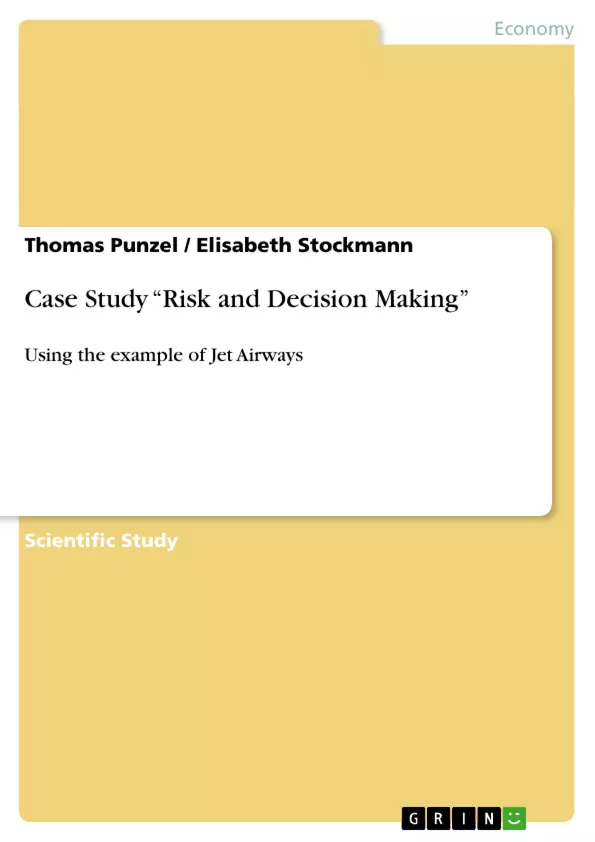Jet Airways is one of the biggest airline companies in India. The company started its
operations in May, 1993 from Mumbai/India. The main products of the company are
passengers air transportation, cargo service and services such as City Check-in or Ramp
handling. Jet Airways operates 340 flights daily and mostly to their 44 domestic
destinations but the company also serves the six following international destinations:
Malaysia, Nepal, Singapore, Thailand and the United Kingdom. Jet Airways’ revenue in
2006 accounted for 1379.9 million USD, which signifies an increase of 38.8%
compared to 2005 (ICFAI, 2005).
The trend of fast global travel goes together with the strong supplier power, as aircraft
manufacturing is dominated by a duopoly. The global airline industry is a deregulated
industry which attracts new entrants (airlines) and the most successful segment is the
domestic one, with a volume of 67.3%. Another indication for more and fast global
travel are growing passenger numbers of 6.5% (2002-2006)(ICFAI, 2005).
Inhaltsverzeichnis (Table of Contents)
- Introduction.
- TOWS- Analysis.
- SAF-Analysis.
- Choice of Strategies
- Risk Assessment...
- Short-Term Strategy..
- Mid-Term Strategy.
- Long-Term Strategy
- Implementation........
- Short-Term Strategy..
- Mid-Term Strategy.
- Long-Term Strategy
- Monitoring & Control.
- Conclusion..
- References..
Zielsetzung und Themenschwerpunkte (Objectives and Key Themes)
This case study focuses on developing a strategic risk management plan for Jet Airways, a major airline company in India. The study employs the TOWS and SAF analyses to identify and evaluate strategic options for the company's future development. Key themes explored in the case study include:- Strategic analysis: Utilizing frameworks such as TOWS and SAF to assess Jet Airways' internal and external environment.
- Risk assessment: Identifying and evaluating key risks facing Jet Airways, such as competition from low-cost carriers and global economic fluctuations.
- Strategic planning: Developing short-, mid-, and long-term strategies to address identified risks and capitalize on opportunities.
- Implementation and monitoring: Outlining steps for implementing chosen strategies and developing mechanisms to monitor and control their effectiveness.
Zusammenfassung der Kapitel (Chapter Summaries)
The case study begins with an overview of Jet Airways, highlighting its position as a leading airline in India and its operations. The TOWS analysis, which identifies the company's strengths, weaknesses, opportunities, and threats, is discussed in the second chapter. This framework serves as a foundation for developing potential strategic options. The third chapter introduces the SAF analysis, a tool used to evaluate the suitability, acceptability, and feasibility of various strategic alternatives. The subsequent chapters focus on specific aspects of strategic planning, including risk assessment and implementation. Chapter 5 outlines a risk assessment process, focusing on short-, mid-, and long-term strategies. The implementation process for these strategies is detailed in Chapter 6. The final chapter, not included in this preview, is dedicated to monitoring and control, providing a concluding discussion on the overall strategic plan.Schlüsselwörter (Keywords)
Key terms and concepts explored in this case study include Jet Airways, strategic risk management, TOWS analysis, SAF analysis, competitive advantage, risk assessment, strategic planning, implementation, monitoring, and control. The case study aims to provide a comprehensive understanding of how these elements can be integrated into a successful strategic plan for a large airline company.- Arbeit zitieren
- Thomas Punzel (Autor:in), Elisabeth Stockmann (Autor:in), 2008, Case Study “Risk and Decision Making”, München, GRIN Verlag, https://www.grin.com/document/122442



